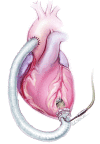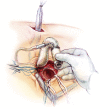The Jarvik-2000 ventricular assist device implantation: how we do it
- PMID: 25452914
- PMCID: PMC4229469
- DOI: 10.3978/j.issn.2225-319X.2014.09.09
The Jarvik-2000 ventricular assist device implantation: how we do it
Abstract
The Jarvik-2000 is a non-pulsatile axial-flow left ventricular assist device (LVAD) that is largely used in patients who present in end-stage heart failure, as a bridge to transplant support or destination therapy. From its first utilization, several implantation techniques have been elaborated, starting from a median sternotomy with cardiopulmonary bypass (CPB) support and moving towards a minimally invasive access with an off-pump strategy. Here we present the favored surgical technique used in our department to implant the Jarvik-2000, in a step-by-step fashion.
Keywords: Jarvik; implantation; off-pump; technique.
Figures










References
-
- Park SJ, Kushwaha SS, McGregor CG. State-of-the-art implantable cardiac assist device therapy for heart failure: bridge to transplant and destination therapy. Clin Pharmacol Ther 2012;91:94-100. - PubMed
-
- Hirsch DJ, Cooper JR, Jr. Cardiac failure and left ventricular assist devices. Anesthesiol Clin North America 2003;21:625-38. - PubMed
-
- Jarvik R.Jarvik 2000 pump technology and miniaturization. Heart Fail Clin 2014;10:S27-38. - PubMed
-
- Westaby S, Frazier OH, Pigott DW, et al. Implant technique for the Jarvik 2000 Heart. Ann Thorac Surg 2002;73:1337-40. - PubMed
Publication types
LinkOut - more resources
Full Text Sources
